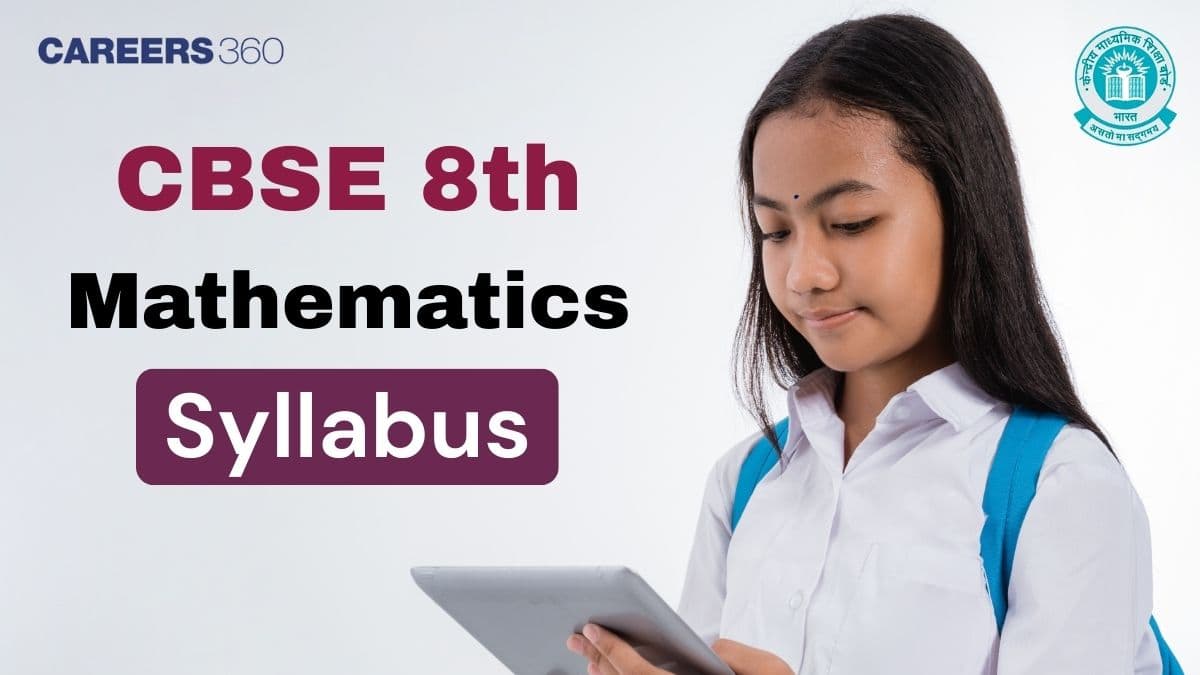CBSE Class 8 Mathematics Syllabus 2025-26 (NCERT Based) – Download PDF
CBSE Class 10th Exam Date:17 Feb' 26 - 17 Feb' 26
CBSE Syllabus for Class 8 Mathematics 2025-26 - CBSE has released the latest Class 8 Maths syllabus 2025-26 online. Most CBSE schools refer to the NCERT books are published and designed for Class 8 students. The CBSE Class 8 Maths syllabus emphasises conceptual clarity and a deep understanding of fundamental concepts. The syllabus for Class 8 Maths is available online at ncert.nic.in. We are providing the NCERT Class 8 Maths syllabus as the CBSE Maths syllabus in this article. The CBSE Class 8 Maths syllabus for 2025-26 includes all chapters and topics found in the NCERT books.

Thoroughly knowing the Class 8 Maths CBSE syllabus for 2025-26 will help in making a proper strategy for exam preparation. The 8th Class Maths CBSE syllabus comprises various topics, subtopics, concepts, and exercises. This is the standard syllabus followed by all CBSE-affiliated schools. Students can download the CBSE Class 8 Maths syllabus PDF to learn about the marking scheme. Read the entire article to know more about the CBSE syllabus for Class 8 Maths.
CBSE Syllabus for Class 8 Maths 2025-26
The Class 8 CBSE Maths syllabus 2025-26 contains 7 chapters. The detailed topics included in each chapter are mentioned in the table below.
CBSE Syllabus for Class 8 Mathematics 2025-26
Chapter No. | Chapter Name | Topics |
1 | A Square and A Cube | Perfect squares and square roots, Perfect cubes and cube roots, Properties of square and cube numbers, Visual patterns with squares and cubes, Estimating square roots and cube roots |
2 | Power Play | Understanding exponents, Laws of exponents |
3 | A Story of Numbers | Types of numbers: natural, whole, integers, rational, Number line representation, Number patterns |
4 | Quadrilaterals | Types of quadrilaterals, Properties of sides and angles, Angle sum property, Diagonals of quadrilaterals |
5 | Number Play | Divisibility rules, Prime and composite numbers, HCF and LCM, Factorisation, Playing with number puzzles |
6 | We Distribute, Yet Things Multiply | Algebraic expressions, Multiplication of algebraic expressions, Distributive law |
7 | Proportional Reasoning-1 | Ratio and proportion, Equivalent ratios, Unitary method, Direct and inverse variation, Real-life applications of proportion |
Prescribed Books for Maths Syllabus for Class 8 CBSE
To score well in the examination, students should practice from the books prescribed by the CBSE for Maths. They have a complete CBSE Class 8th Maths Syllabus, and every topic is explained in an easy way. Students should complete these books first and then start solving samples and previous year's papers.
Exam Preparation Tips for Class 8 Mathematics Syllabus CBSE
The very first step to prepare for the exam is to get familiar with the syllabus of Class 8 Maths CBSE.
After knowing the Class 8 Maths CBSE syllabus, make a proper study timetable.
Practice a number of questions from different sources like sample papers, previous year papers, and reference books.
Clear all your doubts, concepts, and seek advice from teachers regarding the preparation and syllabus of class 8 Maths CBSE.
Check Chapter-wise Solutions of Class 8 Mathematics
Frequently Asked Questions (FAQs)
No, the concepts of the question remain the same, but sometimes students may find some questions coming directly from CBSE books.
Go through the complete CBSE syllabus for class 8 Maths, then make a proper time table and follow it. Regular practice of a variety of questions can help in scoring well in class 8 exams.
Yes, CBSE books are the prime source for the preparation of the exam.
Yes, there are around 20 questions asked from the Maths in the NMMS exam.
Questions related to CBSE Class 10th
On Question asked by student community
HELLO,
If you want admission to 9th grade under the CBSE board in Andhra Pradesh , visit nearby CBSE affiliated schools during the admission period that is generally from January to April or you can check the official websites of the schools in which you are interested for admission if
Hello,
From the below website, you can get the CBSE Maths Sample paper of class 10.
https://school.careers360.com/boards/cbse/cbse-class-10-sample-papers-2025-26
Visit the below website to obtain the previous year question papers of class 10 CBSE.
https://school.careers360.com/boards/cbse/cbse-previous-year-question-papers-class-10
By solving both sample papers and previous year question papers, you can score well in your examination.
Hello,
From the below website, you can get the sample papers of CBSE class 10 Hindi subject.
https://school.careers360.com/boards/cbse/cbse-class-10-sample-papers-2025-26
You'll also get sample papers of other subjects. Refer them to prepare well.
Hello,
If you're from Karnataka Board, then visit the below website to get the key answers of Social Science question paper of SA 1 of class 10.
https://school.careers360.com/boards/kseeb/karnataka-sslc-mid-term-exam-question-paper-2025-26
Let us know if you're from a different board.
Hello,
Since you applied over a month and a half ago and haven't received your 10th-grade certificate, the best course of action is to check the status of your application on the official website. If that doesn't yield results, you should contact your school and the relevant education board's regional
Applications for Admissions are open.
This ebook serves as a valuable study guide for NEET 2025 exam.
NEET Previous 10 Year Questions
Get nowThis e-book offers NEET PYQ and serves as an indispensable NEET study material.
JEE Main Important Physics formulas
Get nowAs per latest syllabus. Physics formulas, equations, & laws of class 11 & 12th chapters
JEE Main Important Chemistry formulas
Get nowAs per latest syllabus. Chemistry formulas, equations, & laws of class 11 & 12th chapters
JEE Main high scoring chapters and topics
Get nowAs per latest 2024 syllabus. Study 40% syllabus and score upto 100% marks in JEE
JEE Main Important Mathematics Formulas
Get nowAs per latest syllabus. Maths formulas, equations, & theorems of class 11 & 12th chapters
